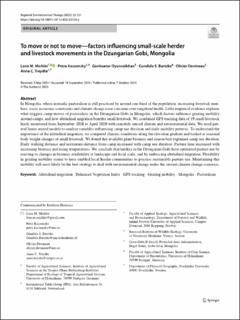| dc.contributor.author | Michler, Lena M. | |
| dc.contributor.author | Kaczensky, Petra | |
| dc.contributor.author | Oyunsaikhan, Ganbaatar | |
| dc.contributor.author | Bartzke, Gundula | |
| dc.contributor.author | Devineau, Olivier | |
| dc.contributor.author | Treydte, Anna C | |
| dc.coverage.spatial | Mongolia, Dzungarian Gobi | en_US |
| dc.date.accessioned | 2024-01-11T09:20:07Z | |
| dc.date.available | 2024-01-11T09:20:07Z | |
| dc.date.created | 2023-10-09T08:52:19Z | |
| dc.date.issued | 2023 | |
| dc.identifier.issn | 1436-3798 | |
| dc.identifier.uri | https://hdl.handle.net/11250/3111020 | |
| dc.description.abstract | In Mongolia, where nomadic pastoralism is still practiced by around one-third of the population, increasing livestock numbers, socio-economic constraints and climate change raise concerns over rangeland health. Little empirical evidence explains what triggers camp moves of pastoralists in the Dzungarian Gobi in Mongolia, which factors influence grazing mobility around camps, and how altitudinal migration benefits small livestock. We combined GPS tracking data of 19 small livestock herds monitored from September 2018 to April 2020 with remotely sensed climate and environmental data. We used general linear-mixed models to analyse variables influencing camp use duration and daily mobility patterns. To understand the importance of the altitudinal migration, we compared climatic conditions along the elevation gradient and looked at seasonal body weight changes of small livestock. We found that available plant biomass and season best explained camp use duration. Daily walking distance and maximum distance from camp increased with camp use duration. Pasture time increased with increasing biomass and rising temperatures. We conclude that herders in the Dzungarian Gobi have optimized pasture use by reacting to changes in biomass availability at landscape and local scale, and by embracing altitudinal migration. Flexibility in grazing mobility seems to have enabled local herder communities to practise sustainable pasture use. Maintaining this mobility will most likely be the best strategy to deal with environmental change under the current climate change scenarios. | en_US |
| dc.language.iso | eng | en_US |
| dc.rights | Navngivelse 4.0 Internasjonal | * |
| dc.rights.uri | http://creativecommons.org/licenses/by/4.0/deed.no | * |
| dc.subject | altitudinal migration | en_US |
| dc.subject | Enhanced Vegetation Index | en_US |
| dc.subject | GPS tracking | en_US |
| dc.subject | grazing mobility | en_US |
| dc.subject | Mongolia | en_US |
| dc.subject | pastoralism | en_US |
| dc.title | To move or not to move—factors influencing small-scale herder and livestock movements in the Dzungarian Gobi, Mongolia | en_US |
| dc.type | Peer reviewed | en_US |
| dc.type | Journal article | en_US |
| dc.description.version | publishedVersion | en_US |
| dc.rights.holder | © The Author(s) 2023 | en_US |
| dc.subject.nsi | VDP::Matematikk og Naturvitenskap: 400 | en_US |
| dc.source.volume | 23 | en_US |
| dc.source.journal | Regional Environmental Change | en_US |
| dc.source.issue | 4 | en_US |
| dc.identifier.doi | 10.1007/s10113-023-02126-y | |
| dc.identifier.cristin | 2182716 | |
| dc.source.articlenumber | 131 | en_US |
| cristin.ispublished | true | |
| cristin.fulltext | original | |
| cristin.qualitycode | 1 | |

